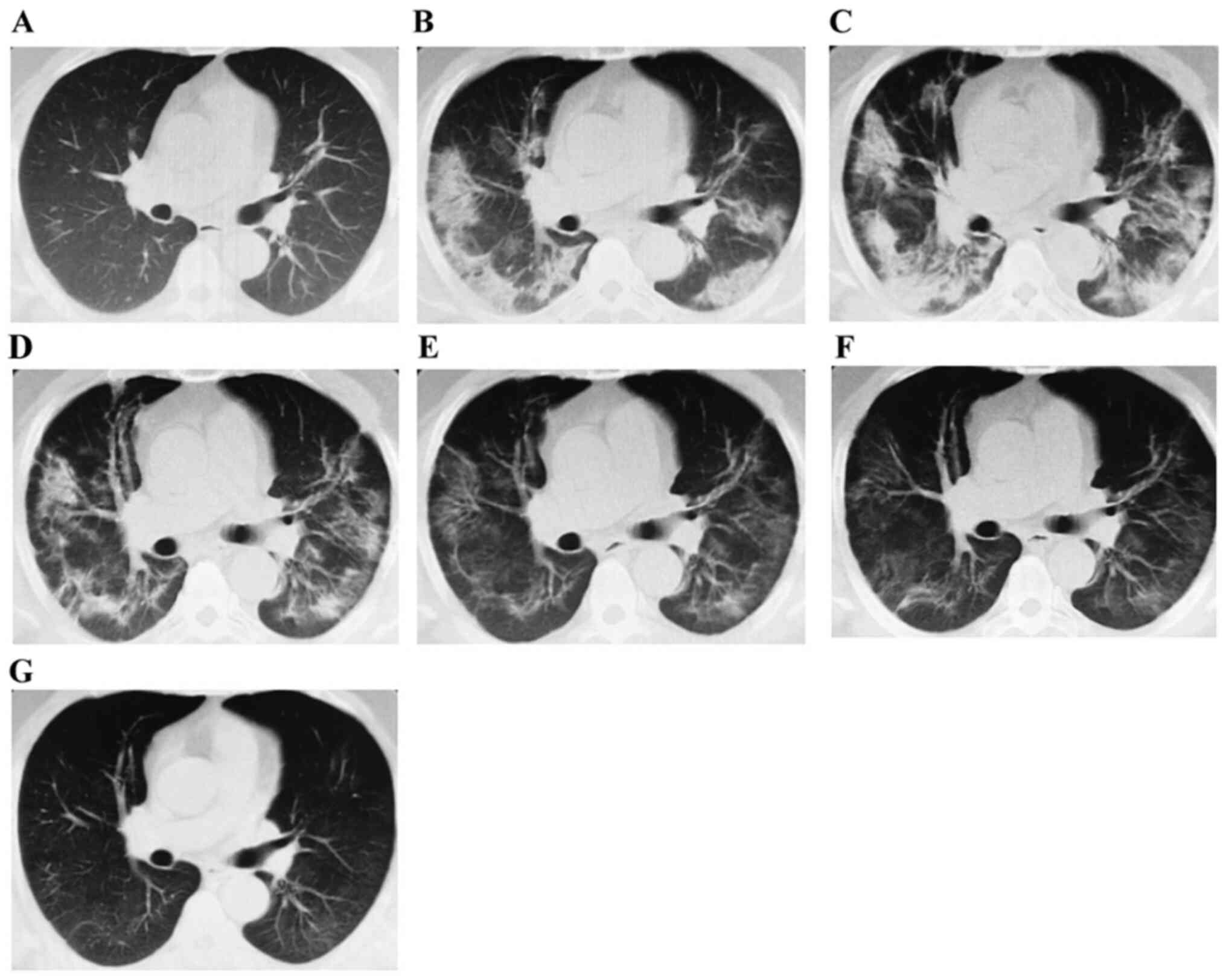|
1
|
Wu JT, Leung K and Leung GM: Nowcasting
and forecasting the potential domestic and international spread of
the 2019-nCoV outbreak originating in Wuhan, China: A modelling
study. Lancet. 395:689–697. 2020. View Article : Google Scholar : PubMed/NCBI
|
|
2
|
Rothe C, Schunk M, Sothmann P, Bretzel G,
Froeschl G, Wallrauch C, Zimmer T, Thiel V, Janke C, Guggemos W, et
al: Transmission of 2019-nCoV infection from an asymptomatic
contact in germany. N Engl J Med. 382:970–971. 2020. View Article : Google Scholar : PubMed/NCBI
|
|
3
|
Wang D, Hu B, Hu C, Zhu F, Liu X, Zhang J,
Wang B, Xiang H, Cheng Z, Xiong Y, et al: Clinical characteristics
of 138 Hospitalized patients with 2019 novel coronavirus-infected
pneumonia in Wuhan, China. JAMA. 323:1061–1069. 2020. View Article : Google Scholar : PubMed/NCBI
|
|
4
|
Chen Y, Liu Q and Guo D: Emerging
coronaviruses: Genome structure, replication, and pathogenesis. J
Med Virol. 92:418–423. 2020. View Article : Google Scholar : PubMed/NCBI
|
|
5
|
Chen ZM, Fu JF, Shu Q, Chen YH, Hua CZ, Li
FB, Lin R, Tang LF, Wang TL, wang W, et al: Diagnosis and treatment
recommendations for pediatric respiratory infection caused by the
2019 novel coronavirus. World J Pediatr. 16:240–246. 2020.
View Article : Google Scholar : PubMed/NCBI
|
|
6
|
Bernheim A, Mei X, Huang M, Yang Y, Fayad
ZA, Zhang N, Diao K, Lin B, Zhu X, Li K, et al: Chest CT findings
in coronavirus Disease-19 (COVID-19): Realtionship to duration of
infection. Radiology. 295:2004632020. View Article : Google Scholar : PubMed/NCBI
|
|
7
|
Fang Y, Zhang H, Xie J, Lin M, Ying L,
Pang P and Ji W: Sensitivity of chest CT for COVID-19: Comparison
to RT-PCR. Radiology. 296:E115–E117. 2020. View Article : Google Scholar
|
|
8
|
Pan Y, Guan H, Zhou S, Wang Y, Li Q, Zhu
T, Hu Q and Xia L: Initial CT findings and temporal changes in
patients with the novel coronavirus pneumonia (2019-nCoV): A study
of 63 patients in Wuhan, China. Eur Radiol. 30:3306–3309. 2020.
View Article : Google Scholar : PubMed/NCBI
|
|
9
|
Song F, Shi N, Shan F, Zhang Z, Shen J, Lu
H, Ling Y, Jiang Y and Shi Y: Emerging 2019 Novel Coronavirus
(2019-nCoV) Pneumonia. Radiology. 297:E3462020. View Article : Google Scholar : PubMed/NCBI
|
|
10
|
Pan F, Ye T, Sun P, Gui S, Liang B, Li L,
Zheng D, Wang J, Hesketh RL, Yang L, et al: Time course of lung
changes at chest CT during recovery from coronavirus disease 2019
(COVID-19). Radiology. 295:715–721. 2020. View Article : Google Scholar : PubMed/NCBI
|
|
11
|
Lin L and Li TS: Interpretation of
‘Guidelines for the diagnosis and treatment of novel coronavirus
(2019-nCoV) infection by the national health commission (Trial
Version 5)’. Zhonghua Yi Xue Za Zhi. 100:805–807. 2020.(In
Chinese). PubMed/NCBI
|
|
12
|
Chung M, Bernheim A, Mei X, Zhang N, Huang
M, Zeng X, Cui J, Xu W, Yang Y, Fayad ZA, et al: CT Imaging
features of 2019 novel coronavirus (2019-nCoV). Radiology.
295:202–207. 2020. View Article : Google Scholar : PubMed/NCBI
|
|
13
|
Drosten C, Günther S, Preiser W, van der
Werf S, Brodt HR, Becker S, Rabenau H, Panning M, Kolesnikova L,
Fouchier RA, et al: Identification of a novel coronavirus in
patients with severe acute respiratory syndrome. N Engl J Med.
348:1967–1976. 2003. View Article : Google Scholar : PubMed/NCBI
|
|
14
|
Ksiazek TG, Erdman D, Goldsmith CS, Zaki
SR, Peret T, Emery S, Tong S, Urbani C, Comer JA, Lim W, et al: A
novel coronavirus associated with severe acute respiratory
syndrome. N Engl J Med. 348:1953–1966. 2003. View Article : Google Scholar : PubMed/NCBI
|
|
15
|
Assiri A, Al-Tawfiq JA, Al-Rabeeah AA,
Al-Rabiah FA, Al-Hajjar S, Al-Barrak A, Flemban H, Al-Nassir WN,
Balkhy HH, Al-Hakeem RF, et al: Epidemiological, demographic, and
clinical characteristics of 47 cases of Middle East respiratory
syndrome coronavirus disease from Saudi Arabia: A descriptive
study. Lancet Infect Dis. 13:752–761. 2013. View Article : Google Scholar : PubMed/NCBI
|
|
16
|
Chan JF, Yuan S, Kok KH, To KK, Chu H,
Yang J, Xing F, Liu J, Yip CC, Poon RW, et al: A familial cluster
of pneumonia associated with the 2019 novel coronavirus indicating
person-to-person transmission: A study of a family cluster. Lancet.
395:514–523. 2020. View Article : Google Scholar : PubMed/NCBI
|
|
17
|
Wong KT, Antonio GE, Hui DS, Lee N, Yuen
EH, Wu A, Leung CB, Rainer TH, Cameron P, Chung SS, et al: Severe
acute respiratory syndrome: Radiographic appearances and pattern of
progression in 138 patients. Radiology. 228:401–406. 2003.
View Article : Google Scholar : PubMed/NCBI
|
|
18
|
Choi WJ, Lee KN, Kang EJ and Lee H: Middle
East respiratory syndrome-coronavirus infection: A case report of
serial computed tomographic findings in a young male patient.
Korean J Radiol. 17:166–170. 2016. View Article : Google Scholar : PubMed/NCBI
|
|
19
|
Dang JZ, Zhu GY, Yang YJ and Zheng F:
Clinical characteristics of coronavirus disease 2019 in patients
aged 80 years and older. J Integr Med. 18:395–400. 2020. View Article : Google Scholar : PubMed/NCBI
|
|
20
|
Yang X, Yu Y, Xu J, Shu H, Xia J, Liu H,
Wu Y, Zhang L, Yu Z, Fang M, et al: Clinical course and outcomes of
critically ill patients with SARS-CoV-2 pneumonia in Wuhan, China:
A single-centered, retrospective, observational study. Lancet
Respir Med. 8:475–481. 2020. View Article : Google Scholar : PubMed/NCBI
|
|
21
|
van den Berg KS, Wiersema C, Hegeman JM,
van den Brink RHS, Rhebergen D, Marijnissen RM and Oude Voshaar RC:
Clinical characteristics of late-life depression predicting
mortality. Aging Ment Health. 25:476–483. 2021. View Article : Google Scholar : PubMed/NCBI
|















